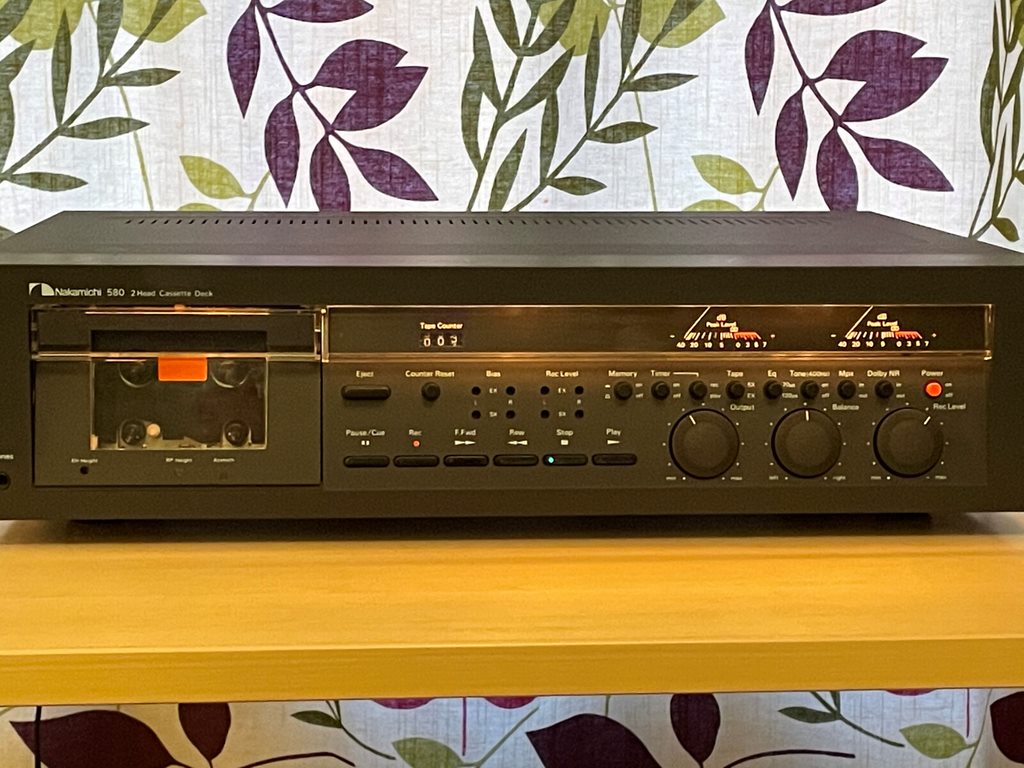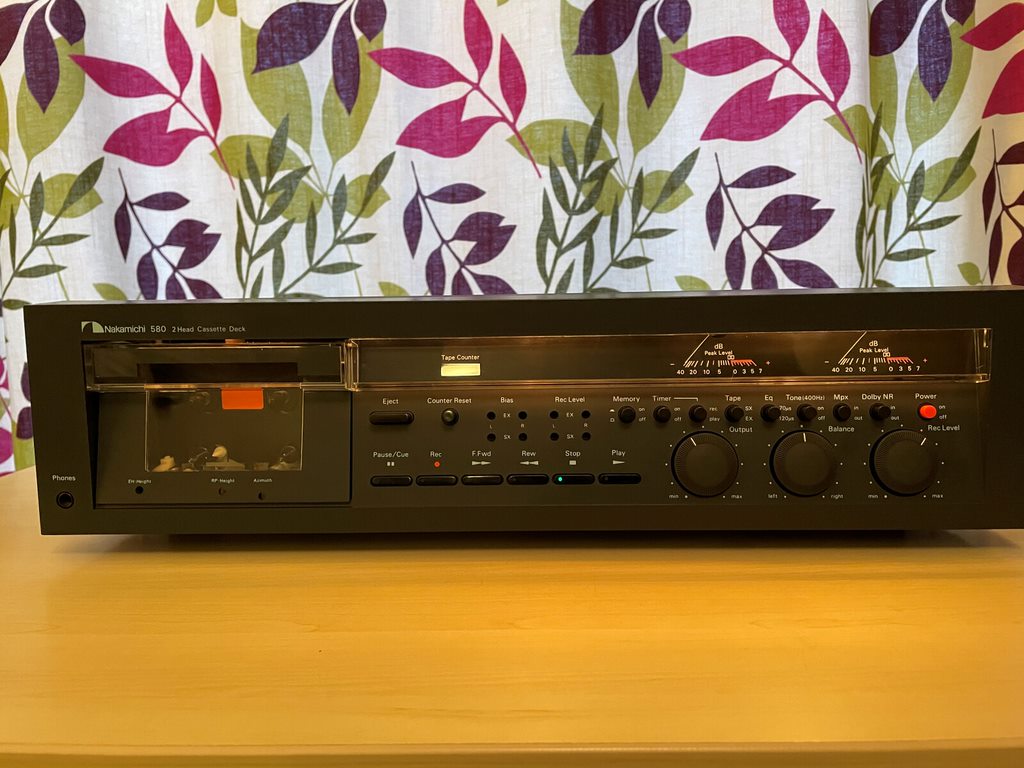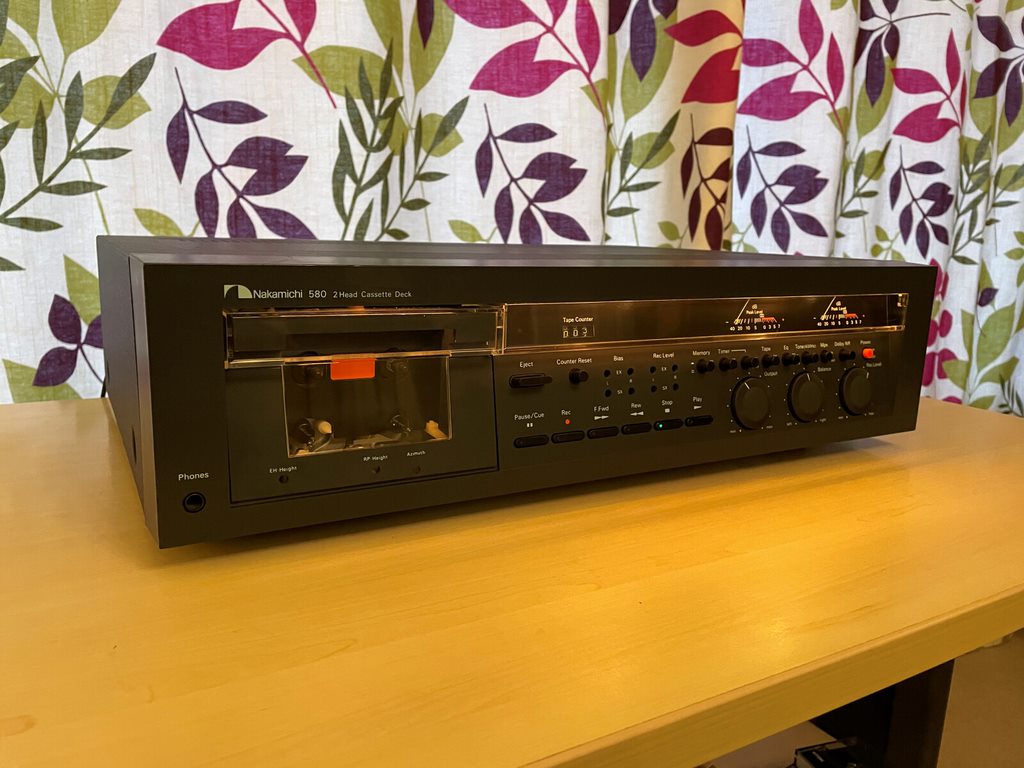You are using an out of date browser. It may not display this or other websites correctly.
You should upgrade or use an alternative browser.
You should upgrade or use an alternative browser.
Evolution of cassette decks (1970s Akai & Marantz vs 1980s Technics etc)
- Thread starter ToTo Man
- Start date
Werner
pfm Member
df_genius PM'd me yesterday to inform me ...
Perfect timing! Now we are awaiting pictures, reports, impressions, ...
I am near finishing the restoration of a very rare Rotel RD-870, one of the best 2-head machines ever made. I had to source a NOS Canon head (from Nakamichi spares, cost me more than the 870 itself), and while the thing lay disassembled on the table I decided to add Yamaha/NAD-style Play Trim to it, turning it into, what I hope, a perfect playback/archival machine.
Talking about the limits of Dolby B, did anyone have a JVC SANRS deck? I remember back in the day being quite impressed with this Dolby alternative.
Super ANRS indeed did some treble de-emphasis/re-emphasis in order to avoid treble saturation. The idea was later copied in Dolby C. Here is a review of a Super ANRS deck: https://www.hifiengine.com/hfe_downloads/index.php?jvc/jvc_kd-a7_audio_may_1981_en.pdf.
But of course with a really good deck, with really good heads, and the tape driven to within a micron of its limits, one could get as much dynamic range without noise reduction as with a lesser deck with Dolby B.
Arkless Electronics
Trade: Amp design and repairs.
NEAL 103 and Tandberg TCD-320 about the best 2 head machines I've heard.
flatpopely
Prog Rock/Moderator
I bought a Nakamichi 580 from Stevec57 on this very forum. A bit of tlc and lots of hours and it makes and plays back superbly, from something that was dead. 2-head but with the classic Nak transport and RP53 head.



flatpopely
Prog Rock/Moderator
If it was a 5xx NAK but not the 580 then it didn't have the Crystalloy RP53 head.
Del monaco
Del Monaco
I still have a Marantz SD 35. It was among the first second hand pile I bought. I cleaned it up last year and it’s not too shabby. Nice sound.
Werner
pfm Member
If it was a 5xx NAK but not the 580 then it didn't have the Crystalloy RP53 head.
But if it was a three-head 5xx NAK then it did have Crystalloy rec and pb heads.
As did all three-head Nak models with exception of the antique 1000/1000II, 700/700II.
Robert
Tapehead
Perfect timing! Now we are awaiting pictures, reports, impressions, ...
I am near finishing the restoration of a very rare Rotel RD-870, one of the best 2-head machines ever made. I had to source a NOS Canon head (from Nakamichi spares, cost me more than the 870 itself), and while the thing lay disassembled on the table I decided to add Yamaha/NAD-style Play Trim to it, turning it into, what I hope, a perfect playback/archival machine.
Super ANRS indeed did some treble de-emphasis/re-emphasis in order to avoid treble saturation. The idea was later copied in Dolby C. Here is a review of a Super ANRS deck: https://www.hifiengine.com/hfe_downloads/index.php?jvc/jvc_kd-a7_audio_may_1981_en.pdf.
But of course with a really good deck, with really good heads, and the tape driven to within a micron of its limits, one could get as much dynamic range without noise reduction as with a lesser deck with Dolby B.
SANRS pumps and breathes quite badly on dynamic material. It's best used to get decent results from basic cooking ferric tape.
Nice idea though, better implemented in Dolby C with less obvious side effects.
flatpopely
Prog Rock/Moderator
IIRC only the 580 had the Nak Crystalloy head, the others had non Nak heads.But if it was a three-head 5xx NAK then it did have Crystalloy rec and pb heads.
As did all three-head Nak models with exception of the antique 1000/1000II, 700/700II.
Tumeni Notes
pfm Member
My two Technics RS-B555 machines are still going strong - late 1980s purchases, as I recall. Inherited a top-of-the-range RS-B965 dual capstan model from my Dad.
I've had to tweak the FF/Rew on the 555s recently; there's a host of white plastic cogs at the back of the tape well, and if you leave a tape on FF/Rew and let it hit the end stop when the tape runs out, one of the cogs can jump out of position, and then pressing the FF/Rew buttons results in the motor spinning, but no drive to the hubs. Simple repair, take the top off, and poke a plastic spudger in to move the cog on its shaft back into alignment.
The 965 fell down with something similar a few months ago, but I've yet to take it apart; maybe a different mech with it being the dual capstan drive. Update to follow.
Started off with, I think, an RS-M216, I had the RS-B11W dual model at one stage, and sometime in the 1990s or early 2000s, I got what was intended to be a replacement for the 555, but as soon as I played the first few cassettes, I could tell there was something wrong with it - playback would wander over the stereo image, etc. Can't recall why I didn't take it back to the supplier, but I ended up relegating it to a back shelf. Not sure what the model number of that was.
I've had to tweak the FF/Rew on the 555s recently; there's a host of white plastic cogs at the back of the tape well, and if you leave a tape on FF/Rew and let it hit the end stop when the tape runs out, one of the cogs can jump out of position, and then pressing the FF/Rew buttons results in the motor spinning, but no drive to the hubs. Simple repair, take the top off, and poke a plastic spudger in to move the cog on its shaft back into alignment.
The 965 fell down with something similar a few months ago, but I've yet to take it apart; maybe a different mech with it being the dual capstan drive. Update to follow.
Started off with, I think, an RS-M216, I had the RS-B11W dual model at one stage, and sometime in the 1990s or early 2000s, I got what was intended to be a replacement for the 555, but as soon as I played the first few cassettes, I could tell there was something wrong with it - playback would wander over the stereo image, etc. Can't recall why I didn't take it back to the supplier, but I ended up relegating it to a back shelf. Not sure what the model number of that was.
Werner
pfm Member
IIRC only the 580 had the Nak Crystalloy head, the others had non Nak heads.
Part of Nak's claim to fame were the crystalloy discrete heads as used in each and every three-head model that came after the original 1000/700 of the 1970s. That means from the 581 right to the DR-10.
When it comes to combined rec/play heads then the only one made of crystalloy was used in the original version of the 580. The head format and the material were not compatible with metal tape (1979), so later 580s and the metal-ready 580M used sendust heads, as did the other classic two-headers, the 480 and 480Z. It is not certain if these heads were Nak-made or bought-in.
Then from the BX-series on (1982?) all Nak two-headers used Canon-made sendust heads. Again, it is not certain if this was a Nak design, or an off-the-shelf product from Canon. The same head was also used in one Rotel and in all Kyocera decks, but these are very rare machines.
flatpopely
Prog Rock/Moderator
Thanks for the info, very useful.
337alant
Negatively Biased
My Tascam 122 mk2 is a fantastic machine as well, I also have a Mk3 version but the speed is way too fast so I will have to fix it
 IMG_2578 by Alan Towell, on Flickr
IMG_2578 by Alan Towell, on Flickr
Alan
 IMG_2578 by Alan Towell, on Flickr
IMG_2578 by Alan Towell, on FlickrAlan
ToTo Man
the band not the dog
It's been a couple of months since I last used my GXC-570D that David refurbished for me.
I'm not exactly sure how but the Maxell XV tape I used to do the testing in April got chewed when I tried to fast forward it (properly chewed, - the tape wrapped itself around the near side of the take up spool, so simply turning the supply spool back manually won't help, - I'll need to unscrew the casing, cut the damaged section out and splice it, - hardly worth the effort for a £2 tape!). So I reached for a new XV tape to do some more test recordings.
The purpose of these tests was to establish the input level and rec cal level settings that give the closest left/right matching during recording and playback. Matching the levels for a 400Hz calibration tone does not yield matched results for a 100Hz-10kHz periodic pink noise signal or mono music programme, so I've constructed a very useful spreadsheet that tells me where the input pots need to be set for the left and right channels to match with various input signals (yes, utterly anal, I know!).
Thinking I was home and dry I made a recording of some real music, a stereo track, and set the input levels not to peak higher than -1dBVU. Upon playing back the recording I noticed high frequency distortion (e.g. the kind of spitty sibilance on consonants when you have too much fluff on your stylus), but I also noticed interesting high frequency artefacts.
The former is common and is a result of recording at too high a level, but I'm puzzled by the latter. It sounds like the drummer is adding more hi-hat beats and maracas that aren't there on the original recording, almost like a pre/post-echo effect that's generating a distinctive 'wet' sounding ambience. The more I hear it the more I'm warming to it, but I shouldn't because it isn't supposed to be there! Lowering the input level by -6dB reduces the high frequency distortion (and also improves the DR score slightly), but the ambience-generating artefacts are still there.
I've prepared a couple of 7 second samples* and would be grateful for advice on what these artefacts are and what is likely to be causing them. Dave calibrated the deck using a Maxell XV tape from the same pack of tapes I'm still using, so I wouldn't have thought the biasing requirements would change.
* I have purposely chosen an obscure piece of music and have limited the recordings to less than 7 seconds to minimise potential copyright issues, but I appreciate that Tony still won't want these to be linked to on a public forum, so if you're interested in hearing these samples please PM me.
I'm not exactly sure how but the Maxell XV tape I used to do the testing in April got chewed when I tried to fast forward it (properly chewed, - the tape wrapped itself around the near side of the take up spool, so simply turning the supply spool back manually won't help, - I'll need to unscrew the casing, cut the damaged section out and splice it, - hardly worth the effort for a £2 tape!). So I reached for a new XV tape to do some more test recordings.
The purpose of these tests was to establish the input level and rec cal level settings that give the closest left/right matching during recording and playback. Matching the levels for a 400Hz calibration tone does not yield matched results for a 100Hz-10kHz periodic pink noise signal or mono music programme, so I've constructed a very useful spreadsheet that tells me where the input pots need to be set for the left and right channels to match with various input signals (yes, utterly anal, I know!).
Thinking I was home and dry I made a recording of some real music, a stereo track, and set the input levels not to peak higher than -1dBVU. Upon playing back the recording I noticed high frequency distortion (e.g. the kind of spitty sibilance on consonants when you have too much fluff on your stylus), but I also noticed interesting high frequency artefacts.
The former is common and is a result of recording at too high a level, but I'm puzzled by the latter. It sounds like the drummer is adding more hi-hat beats and maracas that aren't there on the original recording, almost like a pre/post-echo effect that's generating a distinctive 'wet' sounding ambience. The more I hear it the more I'm warming to it, but I shouldn't because it isn't supposed to be there! Lowering the input level by -6dB reduces the high frequency distortion (and also improves the DR score slightly), but the ambience-generating artefacts are still there.
I've prepared a couple of 7 second samples* and would be grateful for advice on what these artefacts are and what is likely to be causing them. Dave calibrated the deck using a Maxell XV tape from the same pack of tapes I'm still using, so I wouldn't have thought the biasing requirements would change.
* I have purposely chosen an obscure piece of music and have limited the recordings to less than 7 seconds to minimise potential copyright issues, but I appreciate that Tony still won't want these to be linked to on a public forum, so if you're interested in hearing these samples please PM me.
Last edited:
ToTo Man
the band not the dog
I've discovered what the problem was!...
I was capturing the tape's output to my ADC in Tape Monitor mode while the tape was recording. I thought it was ok to do this on a 3-head deck as I've seen CassetteComeback compare in real-time the quality of his source vs tape this way.
Evidently this does not produce good results on the Akai, - the record and playback heads are very close together so there must be some crosstalk going on between the two heads when monitoring in real-time.
Replaying the recording after the event in 'play-only mode', it sounds much more like the source and doesn't have the somewhat frantic doubling up of hi-hat strikes etc!
I was capturing the tape's output to my ADC in Tape Monitor mode while the tape was recording. I thought it was ok to do this on a 3-head deck as I've seen CassetteComeback compare in real-time the quality of his source vs tape this way.
Evidently this does not produce good results on the Akai, - the record and playback heads are very close together so there must be some crosstalk going on between the two heads when monitoring in real-time.
Replaying the recording after the event in 'play-only mode', it sounds much more like the source and doesn't have the somewhat frantic doubling up of hi-hat strikes etc!
Last edited:
ToTo Man
the band not the dog
Thanks for confirming this, Werner.Record-time crosstalk into the play head is typical for sandwich heads, as opposed to discrete heads. This seems to be a very severe case. But let’s not forget that the Akai comes from a time when the industry was only just starting to enjoy sandwich heads.
The problem perhaps isn't as bad as I'm making it out to be - my dad thinks I'm mad because he can't hear it! - but it's one of those things that's very difficult to 'unhear' once your ears latch onto it. It's no big problem, monitoring in real-time isn't essential for me, I'm just glad the problem isn't present during playback!
PS - I've sent you a PM with a link to the samples if you're interested to hear.

